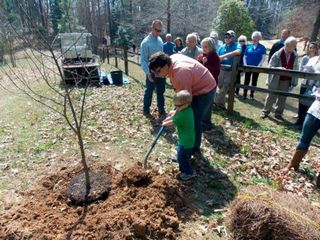City of Hoover’s 17th Annual Arbor Day Celebration

Hosted by the Hoover Beautification Board
9:30 a.m. Tree giveaway
10:30 a.m. Arbor Day ceremony featuring fourth-grade Arbor Day essay contest winners
11 a.m. Ceremonial tree planting
LIST OF AVAILABLE TREE SPECIES – IN ORDER OF MATURE SIZE
Most of these trees will be planted out of 3 gal. containers and will range in height from 3 to 6 feet.
Longleaf pine will be planted out of one gallon containers and will range in height from grass stage to 3 feet tall.
American Fringe Tree (Chionanthus virginicus) – Small deciduous tree or shrub that can reach 15-20’ in height. Typically found on moist soils in the forest understory. Produces white, fragrant flowers in spring, grooved and scaly bark, and blue-black drupe fruit. An under-utilized but very popular ornamental that is an excellent replacement for flowering dogwood.
Flowering Dogwood (Cornus florida) – Small deciduous tree that grows slowly to 20’ tall at maturity. Requires shade and well-drained soils. Produces interesting bark and fruit. Typically has white flowers and red fall color. Popular ornamental but prone to Dogwood anthracnose and numerous other cultural problems.
Southern Crabapple (Malus angustifolia) – Small deciduous tree that grows quickly to 25’ tall at maturity. Showy flowers in the spring with thorns along the branches. Tolerates a variety of sites but prefers shade. Produces small, yellow-green sour apples that are highly desirable to wildlife.
Eastern Redcedar (Juniperus virginiana) – Medium sized evergreen conifer that grows 40-50’ high by 8-20’ wide. Aromatic foliage, interesting fruit and somewhat showy, exfoliating bark. Tolerant of adverse site conditions but prefers full sun and alkaline soils. Variable branching habit in the wild.
American Beech (Fagus grandifolia) – Medium to large sized deciduous tree that grows 50-60’ high with numerous spreading limbs that form a broad, round-topped and compact canopy. Unique characteristics include smooth, light gray bark, prickly stalked fruit, sharp-pointed buds and leaves persisting through winter. Prefers rich moist bottom-lands but occurs on gravelly slopes and rich uplands. Beech nut fruit is highly desirable to wildlife.
Baldcypress (Taxodium distichum) – Large deciduous conifer that typically grows 50-70’ high but can grow to 100’ or more. Versatile tree that is commonly found on wet sites but is also highly tolerant of dry sites and drought-like conditions. Beautiful, rust fall color and compact pyramidal shape.
Southern Red Oak (Quercus falcata) – Large, deciduous shade tree that grows 60-80’ tall on dry, gravelly uplands and rich bottom lands. Has large, spreading branches and open canopy. Interesting leaf shape and color contrast between upper and lower leaf surface. Copper fall color. Low tolerance for site disturbance. Produces ½” long acorns that mature over two growing seasons. Part of the red oak group.
White oak (Quercus alba) – Large, deciduous shade tree that grows 60-80’ tall and tolerates a variety of rich soils. Wonderful bark and leaf characteristics. Beautiful mixed fall color. Produces an abundance of ¾” long acorns that mature over one growing season and are highly desirable to deer and other wildlife. Part of the white oak group.
Longleaf Pine (Pinus palustris) – Large, evergreen conifer that grows slowly to 100’ tall with a slightly tapering trunk, stout branches and gnarled limbs that typically form an elongated and irregular canopy that is often 1/3 to 1/2 the length of the tree. Slower growing than other yellow pines but extremely sturdy and highly tolerant of planting site variety and environmental conditions. Produces 6-10” long cones and leaves mostly in clusters of 3 that are 8-18” long. Prefers well-drained, sandy and gravelly soils. The State Tree of Alabama!!!
NOTE: Site selection should include consideration for the tree’s sun tolerance, for its canopy growing up and out, and for its roots being willing and able to spread out underground, without restriction. Because newly planted trees almost always require periodic maintenance, the planting site should be in a location where the tree will not be forgotten. And because schools tend to expand, the planting site should not be in a location that could one day be utilized for expansion.
Photo courtesy: Hoover Sun











